| 1 | Scarlet kingsnake |
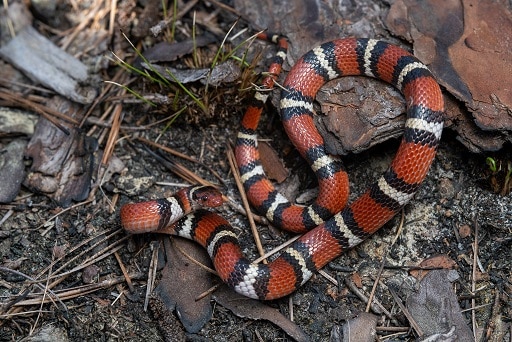
Location: US southeast.
The Lampropeltis genus of kingsnakes has an estimated 45 members worldwide, which are united by the common feature of being extremely powerful constrictors relative to their size. The United States hosts the most members of any nation, and the most common member in Florida is the scarlet kingsnake (Lampropeltis elapsoides).
This species is found in moderate to sparse woodlands, where it loves to bury itself in the soft, mulchy upper layers of soil. Scarlet kingsnakes have a particular tendency to stash themselves beneath strips of rotting bark on old pine trees, which makes them fairly easy to find if you’re on a hunt for one.
Like all kingsnakes, Lampropeltis elapsoides is completely harmless to humans. This species is a mimic of the deadly eastern coral snake, also found in Florida’s woodlands, and is the subject of a famous nursery rhyme: red touches black, venom lack, red touches yellow, kill a fellow. This refers to the colourful stripes, and while the rhyme doesn’t apply outside of the US, it does work in Florida.
Scarlet kingsnakes have one of the most specialised diets of the kingsnake group, as 74% of their diet consists of skinks. They’re particularly fond of two species: the ground skink and southeastern five lined skink. Another 15% comes from snakes, while skink eggs and mice have also been detected.
At a standard range of 40-50cm, and an all-time record of 68.6cm, this is the shortest of all kingsnakes worldwide. Scarlet kingsnakes are most abundant in Florida, Georgia and the Carolinas, but have scattered sightings in Virginia and Louisiana.
| 2 | Desert kingsnake |
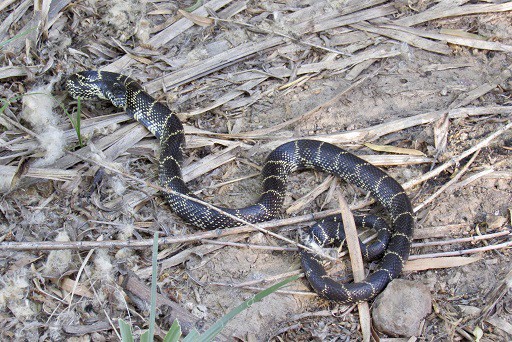
Location: 3 states of the US far south.
This species is found in Texas, Arizona and New Mexico, as well as a swathe of northern Mexico. Sightings of this kingsnake are plentiful around Tucson and San Antonia alike. Despite the name, desert kingsnakes (Lampropeltis splendida) avoid bone dry deserts, and prefer areas with plenty of wispy grass and vegetation. This species is far longer than the scarlet kingsnake of Florida, reaching a record length of 152.4cm.
Desert kingsnakes prey largely on other snakes, with one confirmed species being the checkered garter snake (Thamnophis marcianus). They’re more than capable of eating horrendously venomous species, such as the Sonoran coral snake (Micruroides euryxanthus), which possesses a lethal arsenal of neurotoxins.
Other confirmed snakes in their diet include the great plains ratsnake, western ratsnake, and plains black-headed snake (Tantilla nigriceps). Desert kingsnakes are a friend of ranchers in their native lands, who often view them as a blessing, hoping to reduce more dangerous snakes.
The desert kingsnake is a species of many morphs. Black and yellow are the primary colours, yet the exact positioning and quantity varies considerably. A large proportion are black with thin yellow bands, while a few are almost black. In some, the yellow beats back the forces of darkness to become the primary colour. One individual discovered in Arizona in 2016 had a thin yellow stripe down its spine.
| 3 | Arizona mountain kingsnake |
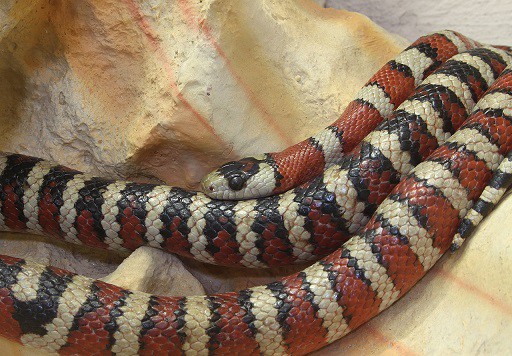
Location: southern US, far northern Mexico.
This kingsnake inhabits four states: Arizona, Utah, eastern Nevada, and extreme western New Mexico. This is a species of sky island mountain ranges, residing at altitudes of above 910 metres and up to 2740 metres.
Arizona mountain kingsnakes (Lampopeltis pyromelana) can be found in chaparral, conifer forests and juniper woodlands, avoiding scorched deserts and preferring areas with plenty of vegetation to get lost in. Within these habitats, the best place for an avid reptile enthusiast to find them is by streams. This kingsnake is intermediate in length, reaching an all time record of 108.8cm.
Because of their mountainous ways, their range is discontinuous, divided into several pockets. Despite this, Arizona mountain kingsnakes are a plentiful species. Research on their diet is lacking, but they’ve been confirmed to feast on bats, specifically the longlegged myotis bat (Myotis volans). There’s also lizards such as Yarrow’s spiny lizard, and like other kingsnakes, they defeat their prey using constriction.
Arizona mountain kingsnakes are recognisable by their bands, which are relatively thin and far more numerous than usual. They also have a snowy white face, rather than red for the scarlet kingsnake.
| 4 | Black kingsnake |
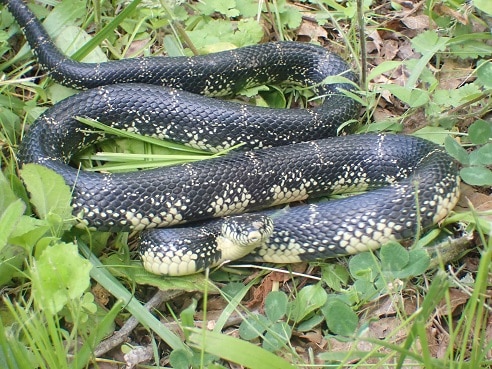
Location: mid-eastern US.
This dark kingsnake is found exclusively east of the Mississippi river. It covers a large swathe of territory, particularly in Tennessee, Kentucky and Illinois, but also Alabama and Mississippi. It’s also found in northwest Georgia, while failing to get anywhere near Florida.
The black kingsnake (Lampropeltis nigra) is one of the longer species, reaching a record of 183cm. They appear in a variety of locations, including farmsteads, forests, woodlands, pasture fields, and even suburban areas. They eagerly climb trees, but are strong swimmers, and are often found close to rivers.
Black kingsnakes have a similar colour scheme to desert kingsnakes, but the key ID sign is that the yellow is more abundant on their flanks, gaining in strength the further down you travel. This snake is non-venomous, but may bite aggressively if picked up.
The black kingsnake has a varied diet, featuring lizard eggs, mammals, birds and other snakes. This species also contained one of the greediest snakes of all time. A black kingsnake was captured in De Soto National Forest in Mississippi in June 2010. While being transported back to base, it regurgitated a whole scarlet snake, an Agkistrodon snake (cottonmouth family), followed by several east diamondback rattle segments.
| 5 | Prairie kingsnake |
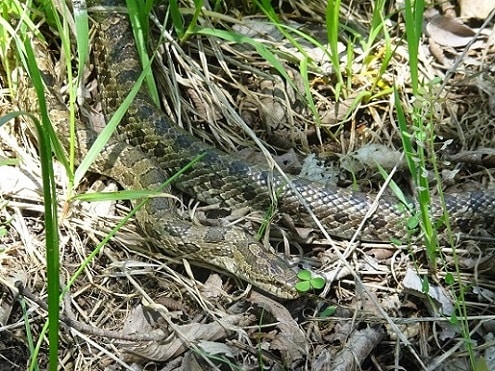
Location: central USA.
A kingsnake of more open areas, rather than claustrophobic forests. Prairie kingsnakes (Lampropeltis calligaster) are most common in spacious grassland with soft soils, often on the edges of woodland. They also appear in pastureland, and commonly hide under logs and debris, staying hidden from predators.
Lampropeltis calligaster is one of the most heavily mammal-eating kingsnakes. A 2019 study examined 1337 individuals gathered from museum collections around the US. Their prey consisted of 69.8% mammals, 24.3% lizards, and 1.2% birds. This is also a relatively fossorial kingsnake, preferring to spend many hours of the day underground. They lack an adapted snout for effortless digging, but have a sixth sense for finding the entrances to preexisting mammal burrows.
This is a species of several central US states: Texas, Kansas, Arkansas, Missouri and Oklahoma. The prairie kingsnake appears nowhere west of Texas, and they’re missing from east coast states such as Florida, Georgia, and the Carolinas.
The largest prairie kingsnake of all time was found in Edmonson County, Kentucky, on May 16th 2005. It was found under a large piece of sheet metal, and measured 143cm. Its weight was 673.6 grams.
| 6 | Mole kingsnake |
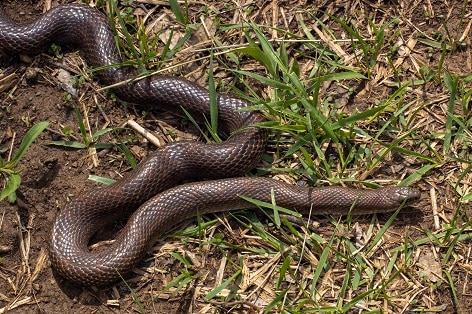
Location: eastern USA.
A close relative of the prairie kingsnake, but found exclusively east of the Mississippi river. Mole kingsnakes (Lampropeltis rhombomaculata) reach a maximum of 119.4cm, with an average of 80-100cm, and inhabit Virginia, North Carolina, South Carolina and the Florida panhandle.
Like the prairie kingsnake, this is a heavily underground-dwelling kingsnake, which is often uncovered by heavy ploughs ripping up farmland. Pastureland is a common hangout for the mole kingsnake, as are disused agricultural fields, spacious pine woodlands, and even fields within urban areas.
Mole kingsnakes mainly prey on mammals, according to a 1979 study from the Carolinas, which found 12 prey from 6 individual snake stomachs. One was a fellow snake, the rough green snake. But the remaining 11 prey were mammals: one unidentified, and ten eastern meadow voles. Mole kingsnakes are themselves swallowed greedily by eastern kingsnakes.
With their dull brown colours, this is one of the harder kingsnakes to recognise. At birth, they’re a light brown-yellow with distinct orange blotches, but with age, they darken so that the blotches are absorbed and disappear. Most adults are patternless.
| 7 | Speckled kingsnake |
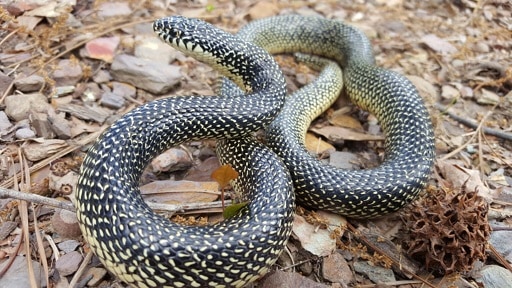
Location: central USA.
A kingsnake with an easily recognsiable pattern. The speckled kingsnake (Lampropeltis holbrooki) lives in Texas, Kansas, Missouri and Arkansas, and has a large overlap with the prairie kingsnake. This species has the same yellow-black colouring as the desert kingsnake, but its speckled pattern is a clear giveaway. These speckles extend even to the face, with only the belly being consistently pale (either cream or yellow).
Moisture is the key for this species. Speckled kingsnakes avoid semi-deserts and parched, wispy grassland, and are more commonly found in streams than other kingsnakes. Lush, grassy fields adjacent to woodlands are a likely place to find them.
When frightened, speckled kingsnakes won’t hesitate to bite, including when picked up. They commonly vibrate their tail like a rattlesnake, which tends to be loudest if the snake is resting on leaf litter. Though typically 90-122cm, speckled kingsnakes reach an all time record of 183cm. Like any snake, they can well exceed the norm if they live in certain spots where prey is incredibly abundant.
The speckled kingsnake is one of the most snake-addicted members, as at least 18 species have been recorded in its diet. These include the coachwhip, timber rattlesnake, copperhead, rough earth snake, and brown watersnake. In 2016, one was gruesomely killed by a lawnmower in Missouri, revealing a Dekay’s brown snake poking out of its stomach.
| 8 | California mountain kingsnake |
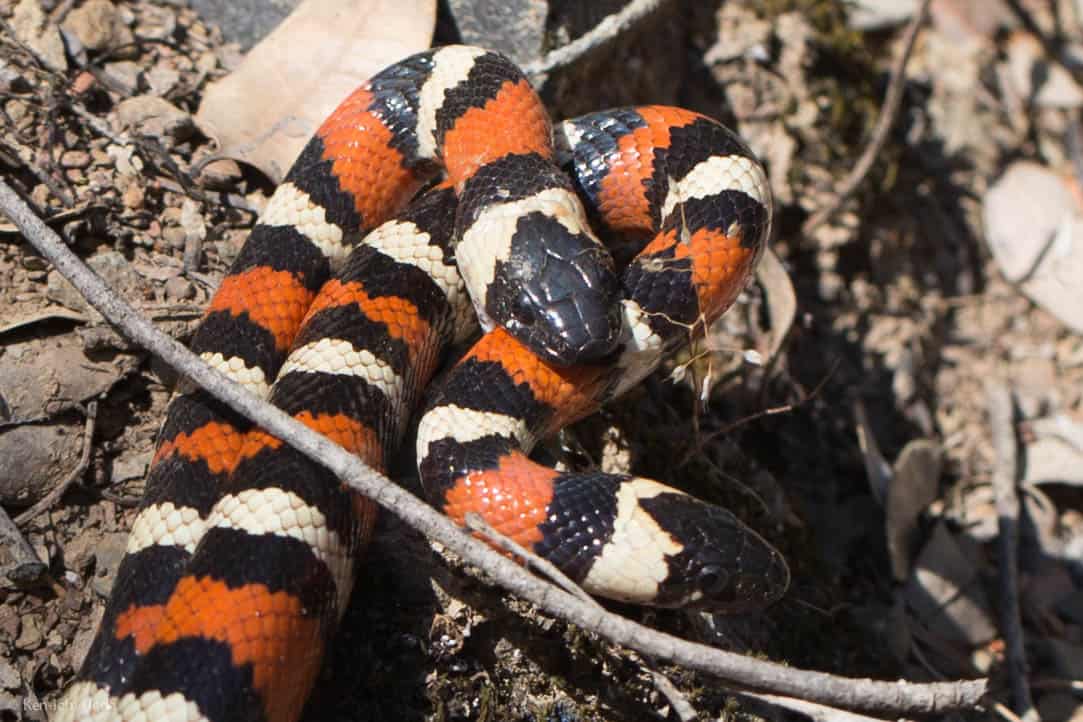
Location: California, Oregon, extreme southern Washington, and Baja California.
A medium-sized kingsnake, which reaches a record of of 117.5cm. Lampropeltis zonata lives in 3 states of the far western USA, and has the classic coral snake mimicking pattern. Everyone’s favourite rhyme still works in California, as this harmless snake has plenty of “red touching black”, and does indeed “venom lack”.
California mountain kingsnakes mainly live at high altitudes, with one of their hotspots being Yosemite National Park in the Sierra Nevada. They’re found in coniferous forest, pine-oak woodlands, chaparral and sage shrublands, usually in areas with plenty of rotting logs and rocks exposed to the sun. This is important for survival, as it allows them to warm their bodies in the cooler mountainous climate.
A 2003 study assessed 51 prey found inside wild California mountain kingsnakes. It revealed this species to be heavily reliant on reptiles, unlike the prairie or mole kingsnakes, which prefer mammals. Their diet consisted of 72.5% lizards, 11.8% lizard eggs, 11.8% mammals, and 3.9% birds. Additionally, 88% of the prey was ingested headfirst. Species detected included the tiger whip-tailed lizard, western fence lizard, southern alligator lizard, Gilbert’s skink and water shrew.
Meanwhile, one of their natural enemies is the fox. In April 2015, on Santa Catalina Island, scientists watched as a fox ran over to a California mountain kingsnake, bit its body, shook the snake around, and ran off into the bushes. It then consumed the snake over 1 gluttonous hour.
| 9 | Grey-banded kingsnake |
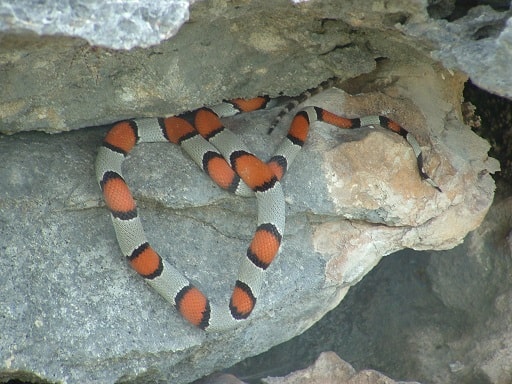
Location: extreme south.
This kingsnake lives in remote desert locations, far from the comfort of Florida or Illinois. They’re found in just two states: Texas and New Mexico, plus a large swathe of northern Mexico.
The grey-banded kingsnake (Lampropeltis alterna) is one of the most dry-loving kingsnakes, favouring arid, rocky landscapes, with heavy amounts of dry shrubs. This species has a current record of 146.7cm, and they’re easily one of the most recognisable Lampropeltis members. Grey-banded kingsnakes have large, circular red blotches, contrasting against grey scales with almost blue tinges, both of which have virtually no markings. They have protuberant eyes with a silvery iris, and a head which is relatively distinct from the neck rather than continuing smoothly.
This kingsnake has some of the scarcest diet research, but apparently has an unusual taste for bird eggs. According to a report from 1997, a grey-banded kingsnake was found near Panther Canyon, Texas with 5 round bulges in its stomach. It soon regurgitated 5 eggs, one of which contained a baby scaled quail (Callipepla squamata).
Other confirmed prey include crevice spiny lizards, canyon lizards, and southern prairie lizards. Reptiles seem to be their favourite, which makes sense for a snake of arid, rocky realms.
In the US, this species ranges from 384 metres, to 1860 metres in the Davis Mountains of Texas. The most northerly record is 2 miles north of the El Paso Gap in New Mexico.
| 10 | California kingsnake |

Location: southwestern USA.
The main species of the Californian lowlands, with California mountain kingsnakes controlling the mountains. Lampropeltis californae is also found in southern Oregon, western Nevada and western Arizona, but it’s southern California where they’re absolutely everywhere, including around major cities like San Diego.
This species is easy to find, as they have extremely flexible habitats, ranging from grassland to woodland chaparral to semi desert. Their diet is equally flexible, as discovered by an extensive 2018 study. Scientists gathered 2662 museum specimens of the California kingsnake and examined their stomach contents. They discovered 447 identifiable prey items, and the result was that mammals and snakes tied for first place, at 29% each.
25% of identified prey were lizards, followed by 11% birds, 5% reptile eggs, and 1% amphibians. Rattlesnakes formed a disproportionate part of their diet, representing 7% of total prey. Pacific rattlesnakes were recorded 17 times and sidewinders 3 times.
California kingsnakes reach a record length of over 2 metres, as recorded on Islas Angel de la Guarda, Baja California. The typical adult length is 76-107cm, which beats the maximum record for scarlet kingsnakes (68.6cm). Like a dog, you can read their mood via their tails – a twitchy tail indicates nervousness.
